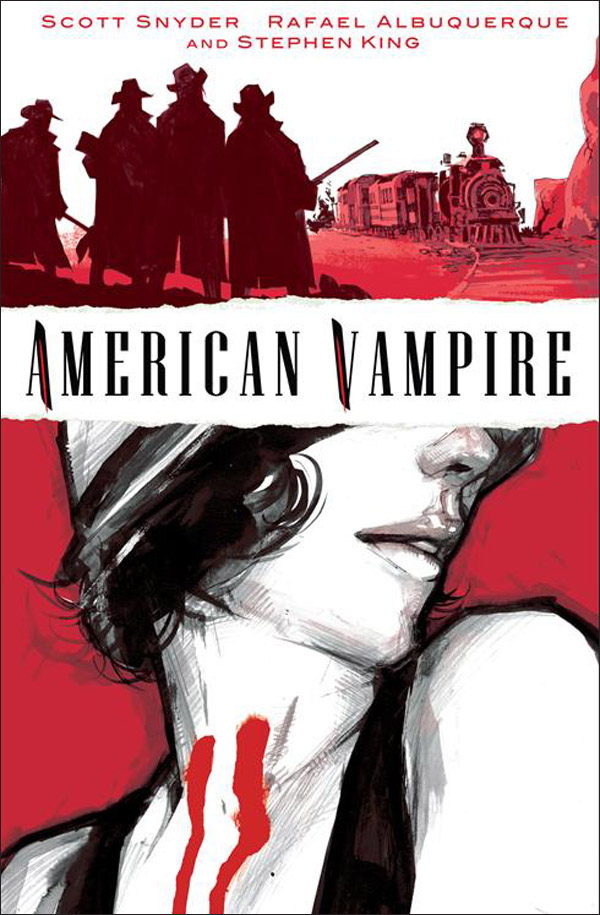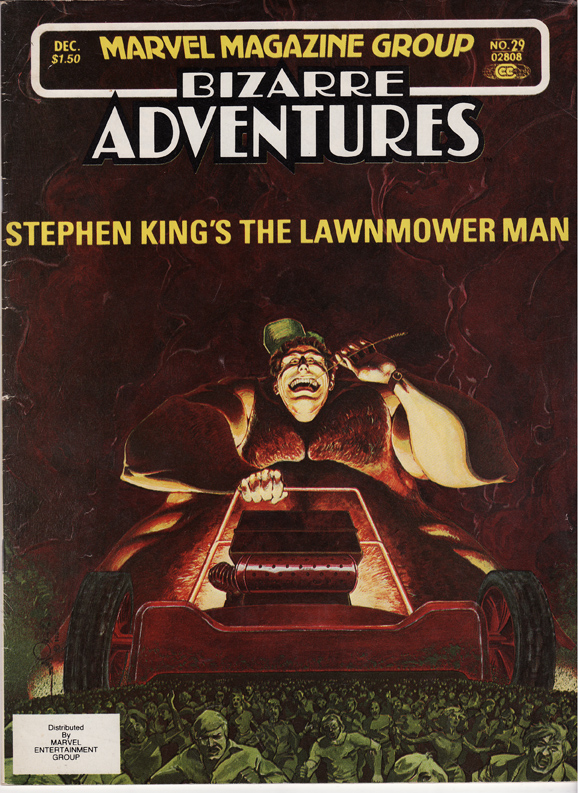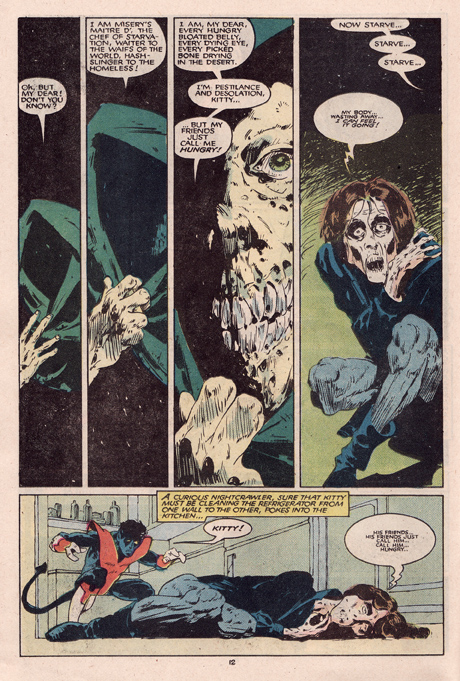The Once And Future King
/
Last week saw the release of American Vampire, Vertigo’s latest ongoing horror series and hopeful heir to other Vertigo top-sellers like Y: The Last Man and 100 Bullets. American Vampire contains two separate but related stories set in different periods of American history—the lead story deals with a young actress in 1920s Hollywood who runs afoul of bloodsuckers of many kinds, and the second feature gives the origin story of an old west outlaw in the 1880s as he becomes the first of a new breed of vampire. This was a pretty solid first issue, co-written by newcomer Scott Snyder and featuring eye-catching art by Rafael Albuquerque (Blue Beetle, Superman/Batman), who’s been long overdue for superstar status. Thankfully, he’ll have a pretty decent chance of receiving his due recognition now, thanks to the book’s other co-creator—Stephen King, who pens the second story that’ll run as a backup feature in the first five issues. This honest-to-goodness original comics work by King was probably inevitable, as the blockbuster novelist has been getting tons of attention in the comics field these days. Marvel has made a veritable cottage industry out of adapting his work into comics form (The Stand, The Dark Tower, N), and Del Rey recently got into the act with their adaptation of The Talisman, King’s collaboration with Peter Straub. Even King’s son, novelist Joe Hill (20th Century Ghosts, Heart Shaped Box) has gotten into the act, with the excellent Locke & Key from IDW, which I reviewed here). King’s work on American Vampire is quite good—it has a gleefully sadistic grit to it that I think fans of Preacher would enjoy—but Snyder’s lead feature reads a bit more smoothly, I thought. Either way, King’s name will likely bring legions of fans to the series, many of whom would never have given it a second thought, and I suspect that’s the idea. With all this comic-book interest in the King of Horror these days, I thought I’d take a look back at the author’s history in the field. If I’ve missed anything, please feel free to point it out in the comments section—as a Constant Reader, I’m always on the lookout for more King.

The first King/comics crossover that I know of is a pretty rare find these days, and goes all the way back to 1981. Bizarre Adventures #29, part of Marvel’s now-defunct black and white magazine lineup that included Savage Sword of Conan and Rampaging Hulk, featured an adaptation of King’s short story The Lawnmower Man (the original prose version can be found in the Night Shift collection). More people are familiar with the 1992 Lawnmower Man movie starring Pierce Brosnan and Jeff Fahey (Lapidus from Lost!), but I can assure you, King’s story has absolutely zilch to do with director Brett Leonard’s Flowers For Algernon by way of William Gibson premise. In fact, the material was altered so drastically, King successfully sued to have his name removed from the ad campaign! The IMDB maintains that a low-budget short was made in 1987 that hews more closely to the original short, but I have no idea where to find it. I’m not sure why Marvel chose to adapt such a crazy-assed story for their first stab at a King adaptation, but I’m glad they did—it’s a wild read in both its prose and comics form.

For those unfamiliar, King’s story is about an unlucky suburban slob named Harold Parkette who hires the wrong landscaping company to trim his giant lawn. It seems that the Pastoral Greenery company answers to the ancient god Pan, and they employ a morbidly obese, cloven-footed lunatic named Karras and his hellish familiar, a giant red monster of a lawnmower that does his bidding while he runs around naked eating the freshly mown grass. Fearing what the neighbours will say, Parkette tries to call the cops to report a case of indecent exposure, and winds up on the business end of the mower as a result. “God Bless The Grass”, indeed.

This is truly one of King’s weirdest short stories (although that title may yet still belong to Here There Be Tygers from Skeleton Crew), but it’s a ghoulishly good time nonetheless—an exercise in vivid and ridiculous imagery, to be sure. It’s well served by Simonson’s artwork as well; even at this early stage of his career, his dynamic layouts and innovative use of sound effects as a graphic element are undeniably cool. I’ve only come across this magazine twice in my career as a comics retailer, but it’s worth tracking down if you’re a fan of either King or Simonson (or preferably both).

Next up is Creepshow, the comic book tie-in to King’s 1982 cinematic collaboration with George A. Romero. If there hadn’t been a comic to go along with this movie, I think I would have been a little insulted—the film itself is a tribute to E.C. horror comics of the 1950s like Tales From The Crypt and Vault Of Horror (King showed some love for these classics in his nonfiction book Danse Macabre). An anthology film featuring five tales of supernatural terror and gruesomely appropriate comeuppance, Creepshow has an awesome cast that includes Ted Danson, Adrienne Barbeau, Hal Holbrook, and a wickedly villainous turn from Leslie Nielsen of all people. It also stars E.G. Marshall (the President from Superman II!) as a reclusive billionaire asshole in the Howard Hughes tradition, and best of all, it features the disco-dancing skills of a young Ed Harris. The film even utilizes comic book panels in its framing sequence, and is hosted by a robed skeleton dude not unlike the Cryptkeeper. The Creepshow comic, released in an 8 X 11 graphic album format by Plume Books, is drawn by horror great Berni Wrightson, no stranger to King collaborations—the genre legend provided illustrations for King’s Cycle Of The Werewolf and the expanded edition of The Stand. In Creepshow, he totally captures Tom Savini’s amazing creature designs for a man who turns into a vegetable (appropriately enough, since Wrightson co-created Swamp Thing)...

...a toothsome, ravenous Yeti...

...and all manner of those zombies that all the kids are into these days.

The Creepshow graphic novel (featuring a cover illustration by E.C. Comics great Jack Kamen) is sadly out of print and fetches a pretty penny online, but keep your eyes peeled the next time you’re at a yard sale or in a used bookstore—there are a lot of copies floating around out there.



So those are all the King comics I know about, right up until Marvel began adapting and spinning off tales from the Dark Tower universe. One of these days, I’d love to see somebody publish some sort of anthology where different creators could adapt King’s short stories into comic book form. There are certainly plenty such stories out there—I believe there are currently five short story collections in print, and then there are the novellas, and shorter works for other anthologies as well. A King short story anthology could conceivably run for years and years before running out of stories to adapt, and the name brand recognition would help it overcome the fate of so many other anthology books in today’s marketplace. Until then, hail to the King, baby!




